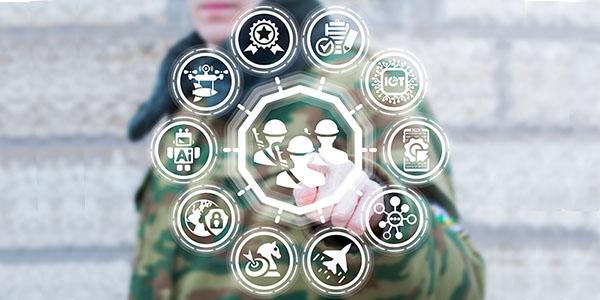Army Officials Teach Information Advantage 101
The U.S. Army needs to conduct five essential tasks to achieve the kind of information advantage that will allow commanders to make faster, more effective decisions than their adversaries. Those tasks are to enable decision making, protect friendly information, inform and educate domestic audiences, inform and influence international audiences and conduct information warfare.
The tasks were approved as part of a larger “logic map” during a February forum of one-, two- and three-star generals, according to Brig. Gen. Paul Craft, USA, commandant, U.S. Army Cyber School. Gen. Craft moderated a panel during the AFCEA TechNet Augusta conference in Augusta, Georgia.
“We established and agreed to this logic map, and then we farmed out the core tasks at the bottom to the very centers of excellence across TRADOC [U.S. Army Training and Doctrine Command] to work on and build out the doctrinal underpinnings to make sure that we’re right and that it all ties into, ultimately, a doctrinal publication that we’ll work on,” Gen. Craft reported. “This also talks about the functions that we have because then form will follow function as we’re looking at different formations that we can have in our forces about how we bring this together.”
Gen. Craft said many of the core functions already exist “at some level of maturity somewhere within our Army’s operations.” He made the point that officials responsible for many of the tasks, such as signal, intelligence, space, cyber and psychological operations officers, already work in Army operations centers at the division and corps levels. But they’re all in different parts of those operations centers and not necessarily collaborating. “Individually, they’re doing great things, but we’re not thinking about how we can work better together.”
The panel also included: Jeffrey Witsken, director, Mission Command Network, Integration Mission Command Center of Excellence; Col. John Perrine, USA, deputy director of operations, U.S. Army Cyber Command; Col. Brian Fickel, USA, director, U.S. Army Public Affairs Center; and Col. Joseph Pischock, USA, director of operations, SOCOM Networks and Services, U.S. Special Operations Command.
Gen. Craft took a unique approach to the panel, asking each member to address one of the five core tasks.
On the first task, enabling decision making, Witsken said the emphasis on information advantage is going to “help focus us in those areas where we particularly have significant challenges.”
Enabling decision making, he explained, involves enhancing the quality of decisions and increasing the speed of those decisions. “One of the first things our adversaries are going to go after is our ability to understand the operational environment and our ability to make decisions. We have to preserve that ability by whatever means,” he said.
Witsken noted that the task involves three elements—human, technical and procedural—and requires teams of humans and machines. “This is about teams of people enabled by information technology and networks, and now increasingly, teams of people integrated with machines and teams of machines that are enabling teams of people,” he asserted. “And all of this is linked by our information technology, our command-and-control applications and services and the underlying network.”
Jeffrey Witsken, director, Mission Command Network, -Mission Command Center of Excellence, U.S. Army: We want decision making much faster than our adversaries so that we have decision dominance. #AFCEATechNet
— George Seffers (pronounced See furs) (@gseffers) August 19, 2021
Col. Perrine tackled task number two, protecting friendly information. “We see core task two as being NETCOM at the enterprise level and then at the tactical level, those G6s and those teams of cyber protectors working together to secure and understand where we’re at because the network enables the transport of the information, the data, and it enables the decision making, the leadership and the combat power.”
Col. Fickel explained the importance of informing the domestic public and divided the task into two parts: providing timely and factual information and correcting misinformation and counter disinformation.
He recalled working with Central Command and seeing the rapid acceleration and spread of propaganda and disinformation from terrorist groups using social media platforms. He also described an incident in which Russia provided close air support for Syrians at an outpost and created a casualty event that killed some Syrian soldiers. Personnel at RT, a state-owned Russian television station, soon began blaming coalition forces for the incident.
“This was our first real delve into actual state-on-state disinformation. That was 2015. It’s now 2021, and those adversary disinformation techniques and capabilities have only increased,” Col. Fickel warned.
Col. Pischock, described the fourth task—informing and influencing international audiences as a core competency for special operations forces. “We’re always out there, and we’re encountering these challenges every day. We’re trying to build human relationships because these human relationships will build the trust that will ultimately lead to effective teams,” he said.
Gen. Craft explained the role of the fifth task, the conduct of information warfare. He described two sets of actors with roles to play: cyber warfare and electromagnetic warfare forces.
The cyber forces, he noted, include both offensive and defensive teams. He cited the 915th Cyber Warfare Battalion, which can be “pushed down to tactical formations,” such as brigade combat teams, divisions and corps.
Gen. Craft also noted that, beginning in October, the Army will be substantially increasing the number of electromagnetic warfare warriors from about 180 per year to 500.





Comments